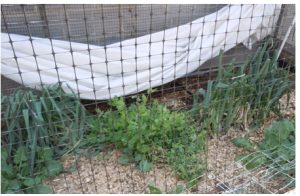By Debbie Roland and
Emmy Ulmschneider
Master Gardeners
If you have ever driven by a cut flower farm or a vegetable market farm, chances are you have seen succession or staggered planting in practice. The reason we succession or staggered plant is to get a continuous supply of the best quality yield throughout the entire growing season. And it makes the best use of our garden space. Most of us grow produce as a love (hobby) to supplement what we purchase. In an era of erratic weather and ever-increasing prices for produce, growing a larger proportion of what we eat has many benefits.
Succession planting does take planning but that can be as simple or complex as you want to make it. In West Texas our growing season is 221 days, with March 29 being our date of last freeze and November 6 being our date of first freeze. As everyone knows these dates can vary – a lot. And these dates can be extended earlier or later if you use row covers or tunnels.

New to succession planting? Keeping records is a good way to start and there are succession planting calculators online. The best thing to do is experiment, keep notes and label what you plant and where. Vegetable crops from greens, peas, corn to root crops can all be grown successively. The information on your seed packet, days to germination, days to harvest, and outdoor planting dates will help you determine the planting interval and how early or late you can sow the seed. For instance, if your seed packet recommends that you sow radish seeds February to March and August to October, that really is the optimum time to plant. You can plant more than once during that period but not outside those guidelines.
If you garden in a small space, it might be best to stick to fast growing vegetables like radishes, peas, and lettuce. Begin with just enough seeds to feed your family for a week. Then each week you will plant that many seeds again. Later in the growing season you may want to switch to a different crop. You can also try to extend the growing season by using row covers.
Have a favorite cut flower? Succession planting is not limited to just vegetables! Try planting your favorite flower successively to enjoy them over a longer period. And what about herbs? Same principles apply to herbs: you can extend the time you harvest annual herbs like basil, dill, parsley, and cilantro by planting them at intervals.
So, grab a notebook, sharpen your pencil, or boot up your computer and go out there, plant and experiment.
For more information, call the AgriLife office at 498-4071 in Odessa or at 686-4700 in Midland or visit aggie-horticulture.tamu.edu or westtexasgardening.org.




